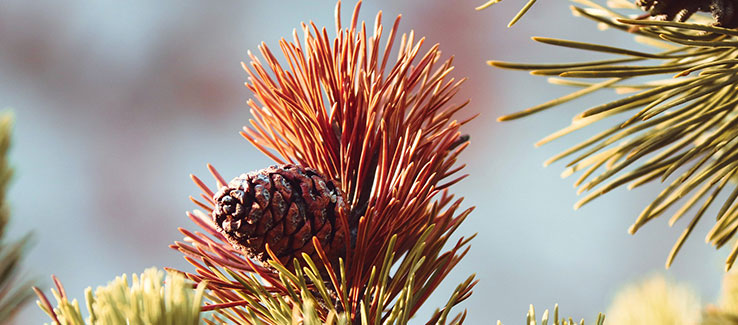Evergreen Tree Diseases
Keep your evergreen trees from dying and spreading killer diseases. By knowing what to look for and how to stop evergreen tree diseases, you can save your trees or have them removed.
fasttreeremovalatlanta.com gathered the following information, symptoms, and treatment for pathogens that attack, weaken, and kill evergreen trees.
Diplodia (Sphaeropsis) Blight
Diplodia sapinea is the opportunistic fungal pathogen responsible for this disease. It affects various 2 and 3 needle pines and conifers. Especially susceptible are red pine, Mugo pine, Scots pine, Ponderosa pine, and Austrian pine. Diplodia blight infects trees of all ages, but higher infection rates are found among trees weakened by drought, infestation, and nutrient deficiencies.
Symptoms of Diplodia Blight – This disease is common among conifers, pines in particular. Signs that indicate a Diplodia blight infection include:
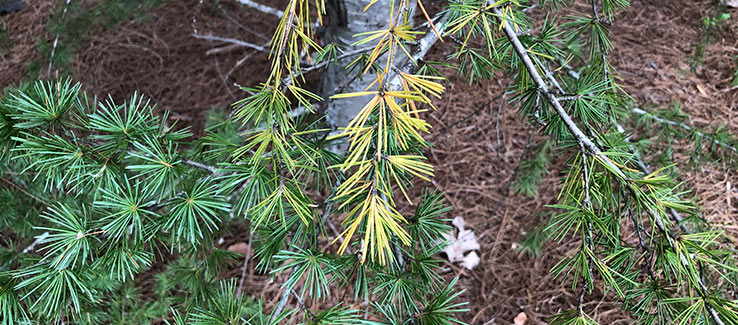
- Stunted, brown needles and stems
- Dying, tan-colored, young needles remain attached
- Pollen cones and mature needles appear uninfected
- Root collar rot in younger trees
- Root disease
- Small, black fruiting structures
In severe cases, entire branches can become infected. Resinous cankers may also form on the stems and trunk of the tree.
During late summer and fall, this disease produces pycnidia (fruiting bodies). Pycnidia are found near the base of needles, on scales of seed cones, or on tree bark. The presence of these fruiting structures, together with other symptoms, is compelling evidence that Diplodia blight has infected your tree.
Treatment of Diplodia Blight – Once a Diplodia blight infection is confirmed, the following management measures should be taken:
- Remove and destroy debris from the base of the tree
- Maintain grass and weeds below the tree trimmed low to the ground (increases airflow)
- Carefully prune out and destroy infected stems and branches (each fruiting structure may contain thousands of spores)
- Apply chemical controls beginning in the spring and every two weeks until new needle growth reaches full length.
If using chemical control, the following chemicals have shown to be quite effective in controlling this disease:
- Copper hydroxide with mancozeb
- Chlorothalonil
- Thiophanate-methyl
- Mancozeb
- Methyl
Prevention of Diplodia Blight – Ways to prevent your trees from contracting Diplodia blight include:
- Plant disease-free trees and shrubs
- Plant disease-resistant species
- Plant your trees far enough from others to maintain good airflow
- Eliminate overhead watering practices
- Care for your trees and encourage healthy growth (water, soil, fertilizer, etc.)
- Prune and cut with sanitized equipment
- Treat your trees preemptively against boring insects
When your tree is more than 25% infected, or the top portion of it has died, call a professional tree service to evaluate the damage and recommend a course of action. If you prune away a quarter of your tree, it will likely die. At this point, removal may be the only option to protect the rest of your landscape.
Cytospora Canker of Spruce
Leucostoma kunzei is the fungal pathogen responsible for this disease. Cytospora canker affects black, Oriental, white, Norway, and, most notably, Colorado blue spruce varieties. Cytospora canker occurs most often on mature landscape trees stressed by drought or poor care conditions.
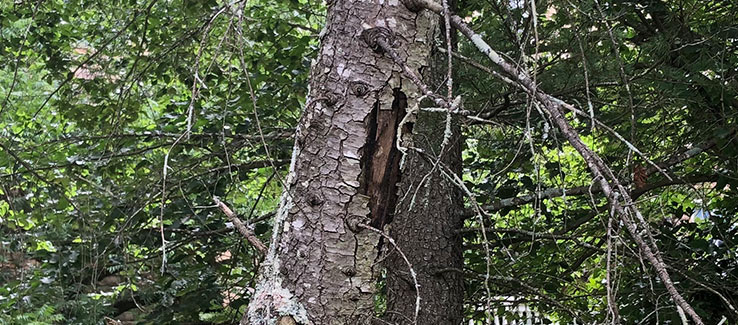
Symptoms of Cytospora Canker – This disease is common among varieties of spruce trees. Signs that indicate a cytospora canker infection include:
- Lower branch dieback
- Poor growth
- Faded or brown needles
- Large amounts of resin flow on affected/dying branches
- Cut the branch to reveal reddish-brown soaked wood
- Small, black fruiting structures
Cytospora canker diseased trees, in decline, will often present the following additional indicators:
- Bark beetle infestation (confirmed by pitch tubes, boring dust, exit holes, galleries beneath the bark, and fast-paced decline from the top-down)
- Spruce spider mites (can cause severe damage)
- Pine needle scale
- Spruce bud scale
As the health of a diseased tree declines, it can be successfully attacked by multiple insect species, making its decline and death an accelerated process.
Treatment of Cytospora Canker – Once a cytospora canker infection is confirmed, the following management measures should be taken:
- Carefully pruning out diseased limbs is the only effective treatment for cytospora canker
- Prune in late winter or dry weather to prevent spreading the disease
- Destroy pruned, infected branches
Tip: Once a tree is infected with cytospora canker, fungicide sprays will have no effect on the disease and will not cure the affected tree.
Prevention of Cytospora Canker – Ways to prevent your trees from contracting cytospora canker include:
- Plant disease-free trees and shrubs
- Plant disease-resistant species
- Plant your trees far enough from others to maintain good airflow
- Care for your trees and encourage healthy growth (water, soil, fertilizer, etc.)
- Increase watering intervals during times of drought
- Have your trees inspected annually to detect any health or insect problems (spider mites, bagworms, etc.)
- Have severely infected trees (dying or dead) promptly removed and destroyed to slow the disease from spreading and eliminate breeding sites for boring insects
When your tree is infected by a disease and infested by boring insects, call a professional tree service to either treat or remove the tree.
Cercospora Blight of Junipers
Pseudo-Cercospora juniperi is the fungus responsible for this disease. Cercospora blight of junipers affects the Cupressaceae (cypress) family, which includes multiple species of junipers and redwoods. Cercospora blight spreads to young foliage in warm, wet weather and can cause a tree to show signs of infection within two to three weeks.
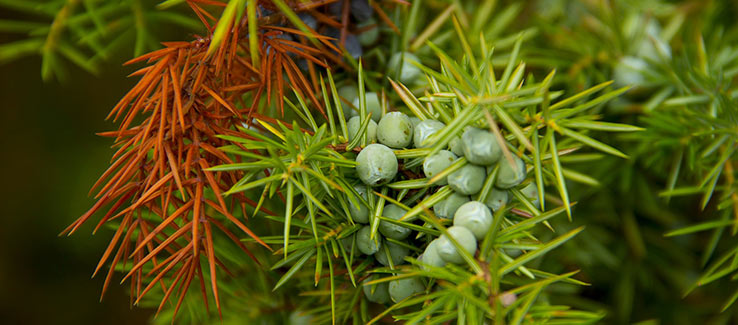
Symptoms of Cercospora Blight of Junipers – This disease is common among varieties of junipers, redwoods, arborvitae, and Eastern red cedar. Signs that indicate a Cercospora blight infection include:
- Lower branch dieback (foliage turns bronze or light brown then gray)
- Inner foliage death occurs first as the disease works outward then upward
- Small fuzzy fruiting structures appear on the dead foliage
Eventually, the dead foliage falls from the tree leaving the inner branches stripped of any foliage or twigs. In advanced cases, the outer foliage also dies off, leaving only the foliage at the very top of the tree.
It is the green (seemingly unaffected) foliage at the end of affected branches that differentiate this pathogen from other blight causing diseases that kill from the infection or canker site out to the tip.
Treatment of Cercospora Blight of Junipers – Once a Cercospora blight infection is confirmed, the following management measures should be taken:
- Apply a liquid or wettable powder fungicide (copper fungicides are recommended) to the lower branches of trees with minor infection evidence. Spray all of the tree’s foliage for heavily infected specimens. Spray the trees in the beginning, middle, and again at the end of the summer season.
- For trees with advanced symptoms of infection (fifty percent or more of the foliage), consider having the tree removed and destroyed to protect other trees on your landscape.
- Carefully remove and destroy dead foliage and twigs from beneath infected trees.
During periods of drought, eliminate all overhead or spray methods of watering. The spread of Cercospora blight depends partly on splashing water and warmth.
Prevention of Cercospora Blight of Junipers – Once a Cercospora blight infection is confirmed, the following preventative measures should be taken:
- Plant disease-free tree species
- Plant disease-resistant species
- Plant your trees far enough from others to maintain good airflow
- Care for your trees and encourage healthy growth (water, soil, fertilizer, etc.)
- Keep grass and shrubbery (surrounding the tree) cut low enough to permit free airflow
- Have your trees inspected annually for early detection of potential issues
Have heavily infected trees removed and destroyed by a professional tree service. As the tree’s health declines, it becomes a target for insect infestations and other infections.
Evergreen Tree Disease Identification
Part of an evergreen tree’s growth process includes the occasional needle or leaf drop. During times of drought, a tree may lose more of its foliage than normal, appearing to be sick.
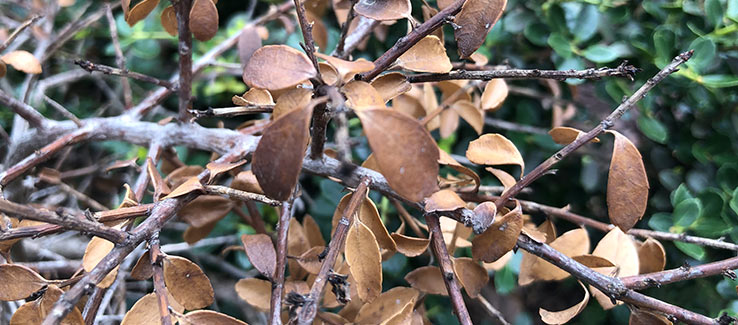
Some insect infestations like bagworms, mites, beetles, and scale can cause chlorosis and leaf drop that appears to be an infection versus an infestation.
When you cannot positively identify whether or not your tree has contracted a disease, call a professional tree service to help you figure out what is happening.
How To Identify and Treat Evergreen Diseases
In this article, you discovered evergreen tree disease information, the symptoms to watch for, and how to treat pathogens that weaken and kill evergreens.
By knowing what to look for and how to treat tree diseases, you can take prompt action to either save your tree or have it removed.
When you ignore the signs of evergreen tree infections, you risk not only losing your tree but spreading the disease to other trees on your landscape.
Sources:
web.extension.illinois.edu/focus/index.cfm?problem=sphaeropsis-diplodia-blight
extension.umd.edu/hgic/topics/cytospora-canker-spruce
hnr.k-state.edu/extension/info-center/common-pest-problems/common-pest-problem-new/Cercospora%20Needle%20Blight%20of%20Juniper.pdf
digitalcommons.unl.edu/cgi/viewcontent.cgi?referer=https://www.google.com/&httpsredir=1&article=1892&context=extensionhist
(404) 220-9965
(404) 220-9963

